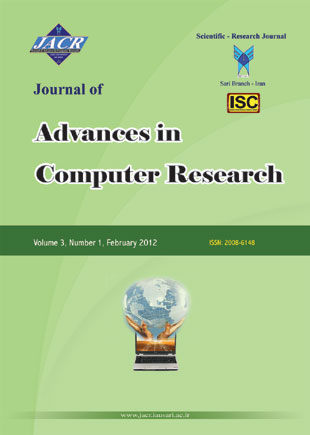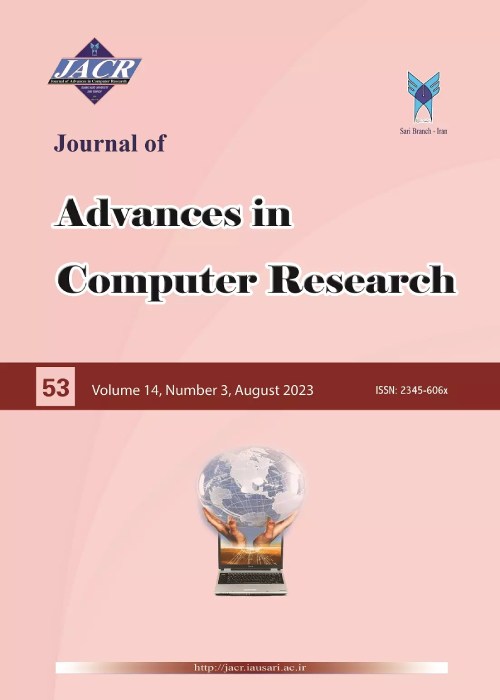فهرست مطالب

Journal of Advances in Computer Research
Volume:3 Issue: 1, Winter 2012
- تاریخ انتشار: 1391/09/26
- تعداد عناوین: 8
-
Page 1This paper presents an automated method for detecting microaneurysms in the retinal angiographic images by using image processing techniques. In the presented method, in order to fade or remove the pseudo images, first retinal images are pre-processed. Then microaneurysms are identified by circular Hough transform. In the existing methods of detecting microaneurysms, it is necessary to identify the vessels in the surface of the retina and to remove them from the background of the image. But in the proposed method, first by using the circular Hough transform the central point of the microaneurysms lesion is identified. Then by using the region growing technique, the total areas of pixels associated with these lesions are identified. In this proposed method due to the removal of the vascular diagnosis which has been very time consuming, the speed of the algorithm has significantly been increased. Results received from the retinal images of five patients show that the accuracy of the proposed method in detecting microaneurysms is about %88.5 that in comparison with other existing methods has higher speed and more accuracy.Keywords: Angiography, Image processing, Circular Hough transform, Diabetic retinopathy, Region growing process, Microaneurysms
-
Page 13Evaporation phenomena is a effective climate component on water resources management and has special importance in agriculture. In this paper, Bayesian belief networks (BBNs) as a non-linear modeling technique provide an evaporation estimation method under uncertainty. As a case study, we estimated the surface water evaporation of the Persian Gulf and worked with a dataset of observations (daily evaporation) in a network of 13 weather stations in the provinces of Hormozgan and Bushehr. Two major categories of methods for learning Bayesian networks are parameter learning and structure learning. In the first step, k2 search algorithm be used as a score-based method for structure learning of BBN. K2 algorithm connects weather stations to other and Makes a virtual network of stations. In the second step, Netica software be applied for parametric learning. Obtained network by k2 algorithm with the help of a probabilistic inference method (reduce gradiant) in Netica can predict the rate of evaporation. The results of the proposed method, indicating that this model has the more accuracy and reliability than existing statistical methods.Keywords: Evaporation, Belief Bayesian Networks, Persian Gulf, Structural Learning, Netica
-
Page 23There area lot of mobile computer devices with a variety of applications and users Tend to use them more. Due to the limitations of mobile devices, running most of the procedures are impossible. To resolve this problem, mobile devices can be connected to the grid, to use the facilities of grid. On the other hand the communication mechanisms are different for each device and they cannot be connected to grid in a stable procedure. In addition, the mobile devices are moving from one place to another and grid cannot manage the successive connection-disconnection of communication. Main idea of this paper is to design an interface for controlling communications between these devices and grid. This interface allows each instrument to be connected to the grid with its own mechanism. For this purpose a database is used in interface. Simulation results show that transaction overhead is low.Keywords: Grid, Mobile Grid, Interface, Bluetooth, Infrared, Wi, Fi
-
Page 33A disk Wang-Bézier type generalized Ball curve is a Wang-Bézier type generalized Ball curve whose control points are disks in a plane. It can be viewed as a parametric curve with error tolerances. In this paper, we discuss the problem of degree reduction of disk Wang-Bézier type generalized Ball curve, that is, bounding disk Wang-Bézier type generalized Ball curves with lower degree disk Wang-Bézier type generalized Ball curves. We propose an algorithm to solve this problem. The algorithm starts by finding an optimal approximation to the center curve of the original disk Wang-Bézier type generalized Ball curve, which is served as the center curve of the degree reduced disk Wang-Bézier type generalized Ball curve. Then the radius of the degree reduced disk Wang-Bézier type generalized Ball curve is computed by solving some linear programming problems, and for which analytic solutions are obtained.Keywords: Wang, Bézier Type Generalized Ball Curve, Degree Reduction, Optimal, Approximation, Degree Elevation
-
Page 51Recently testing of Quantum-dot Cellular Automata (QCA) Circuits has attracted a lot of attention. In this paper, QCA is investigated for testable implementations of reversible logic. To amplify testability in Reversible QCA circuits, a test method regarding to Built In Self Test technique is developed for detecting all simulated defects. A new Reversible QCA MUX 2×1 design is proposed for the test layer implementation regarding to overhead and power savings. Our proposed Reversible QCA MUX 2×1 design resulted in decrease in QCA cell counts and minimal input to output delay. The proposed design is simulated and verified using QCA Designer ver.2.0.3.Keywords: QCA, Reversible, Fault, MUX, Testability
-
Page 65Nowadays, honeypots are widely used to divert attackers from the original target and keep them busy within a decoy environment. DeMilitarized Zone (DMZ) is an important zone for network administrators, because many of the services to the public network is provided at this zone. Many of the security tools such as firewalls, intrusion detection systems and several other security systems can be used to secure DMZ. But honeypots are supplementary devices used to discover attacks and capture forensics against the attackers. The most important solution to secure the DMZ is to detect attacks against servers of this zone and void these intrusions by leading them to honeypots and capturing enough forensics against the attackers. This research work is focused on providing a solution for problem areas such as response to intrusion attempts and redirection of the intruders to honeypots. The proposed system detects malicious activities and redirects them to a decoy system to capture forensics. Honeypots are decoy systems used to interact with attackers and capture forensics from their activities. In the reported work, detection of the malicious activities is carried-out using a Network-based Intrusion Detection System (NIDS). Measuring performance of the proposed system, three important factors are implemented. These factors include accuracy, false positive rate and true positive rate. Accuracy is presented as an important factor to check the performance of the system. In our simulations, the measured accuracy is more than 99 percent. False positive rate is another important factor of this system that shows the failure rate. This parameter is measured less than 0.50 percent that shows the proposed system cannot detect all the attacks against the protected machine, but attack detection is performed using a suitable rate. The last factor of system performance is true positive rate that is measured to be 100 percent. This measurement shows that all of the legitimate traffic is directed to protected machine with proposed system.Keywords: Intrusion Detection, Forensics, Demilitarized Zone, Honeypot
-
Page 81Today, vehicular Ad-hoc Network between automobiles has been accepted by the public, and many people are interested in exchanging information with other vehicles as well as with roadside equipment while driving. When a number of vehicles want to access to the data stored in RSU, the priority of servicing comes into face. In this case, some methods, such as D*S, D*S/N, have been presented so far. In this essay, in addition to investigating these methods, a new one has been suggested which, by using the information of the vehicle speed and GPS data, computes the time in which vehicle is under RSU coverage zone, and if only (t1)excesses the time required for data transferring, the service will be requested. So, it ensures that the data transmission will be done before exiting the vehicle from the RSU coverage zone. We have used NS2 method to evaluate the efficiency of the suggested method. The results of the simulation show that the suggested method has enhanced the efficiency up to 25%.Keywords: VANET, scheduling, roadside unit (RSU)
-
Page 89This study introduces a reversible optical fulladder. Also optical NOT and NOR gates are implemented through Electro-Absorption-Modulator / Photo Detector (EAM/PD) pairs, were utilized for fulfilling reversible R gate. Then, reversible fulladder was designed based on the proposed reversible optical R gate. The operation of the suggested fulladder was simulated using Optispice and it was found that the delay time in comparison with VLSI implemented circuit has remarkably improved.Keywords: Optical Reversible Fulladder, Optical Reversible Gate, EAM, PD, Optical NOR, Gate, Optical NOT Gate


